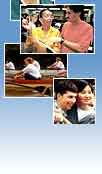![[NEWS AND FACTS BANNER]](/URClipArt/news/titleNewsFactswide.jpg) |
||||||||||||||||

|
||||||||||||||||

Miner Library Collection Cataloged in New Book
|
||||||||||||||||
 |
| BOOKKEEPERS: Edward Atwater '50 (left) and Christopher Hoolihan, rare books and manuscript librarian at Miner Library, look through some of the books that make up the Edward C. Atwater Collection of American Popular Medicine and Health Reform. |
There were certain things an American woman in 1872 was unlikely to ask her
doctor-questions about reproductive health, contraception, and sexuality, for
example. But nearly 100 years before the publication of Our Bodies, Ourselves,
a 19th-century woman could find some information about intimate subjects at
a well-stocked bookstore.
There, the latest version of Edward Bliss Foote's Medical Common Sense,
could be bought, wrapped in a plain brown wrapper, and carried home to
be read in the strictest privacy.
Now housed in the Edward G. Miner Library, a copy of Foote's book and thousands like it make up the Edward C. Atwater Collection of American Popular Medicine and Health Reform, a collection that rivals those found in the National Library of Medicine, the Library of Congress, and at Harvard and Yale universities.
The details of the trove-including more than 5,000 books, pamphlets, and broadsides telling the story of American popular medicine from the late 18th to the early 20th century-are being gathered into a two-volume catalog published by the University of Rochester Press.
The first volume of A Catalog of the Edward C. Atwater Collection of American Popular Medicine and Health Reform, covering authors A-L, was published late last year. A second volume, due in 2004, will cover authors M-Z.
The collection's namesake, physician Edward Atwater '50, started collecting books out of a general interest in medical history and realized that the diverse genre of popular medicine was largely unnoticed by others.
"I realized few people had shown an interest in popular medicine and that there was a body of material of some significance that no one else was collecting in any organized fashion," says Atwater.
His search for materials has taken him to bookstores and book fairs in the United States and Canada-and as far away as the Paris flea market.
The collection includes publications written by health care professionals for a general audience, giving lay readers access to a wide range of health-related information. There are books on anatomy, hygiene, diet, illness, first aid, childbirth, contraception, sexual dysfunction, and venereal disease.
The collection also offers a glimpse of nontraditional approaches, such as botanical therapy and water curing-the precursor to today's spas-and includes examples of commercial scams based less in medicine than on greed.
In 1994 Atwater donated the assortment of books and ephemera he had been amassing for nearly 35 years under the agreement that an annotated catalog would be developed.
"The catalog is what makes the collection interesting," says Atwater. "It's essential that the materials are useful to researchers, otherwise it's just a bunch of old books on a shelf. This way people all over the country, all over the world, can read them and learn from them."
Christopher Hoolihan, rare books and manuscript librarian at Miner Library, took on the task of annotating the collection. Containing more than 2,300 entries for authors in the first half of the alphabet, the first volume spans the 18th century through World War I. Each entry provides a synopsis of the work, its publishing history, and significance to the genre.
"Very few librarians get the chance to work so intensely with collections of this size, quality, depth, scope," says Hoolihan. "From that perspective, it's been very rewarding. Compiling a publication like this has been an important part of my career."
The collection's relevancy, according to Hoolihan, goes beyond medical history and has value for the study of social history, religion, gender issues, as well as advertising and the history of mass circulation. An annotated catalog gives people from any academic or personal interest in popular medicine access to a distinctive body of literature.
"The idea behind the catalog was not just to create a monument to the collection," says Hoolihan. "There are a lot of libraries that crank out print catalogs. The idea of annotating the materials, which is unusual, was to make it a guide to the literature in a way that is both general and accessible so that anyone can use the collection."
Jenny Leonard
Maintained by University Public Relations
Please send your comments and suggestions to:
Rochester Review.
| SEARCH: Directory | Index | Contact | Calendar | News | Giving | |||